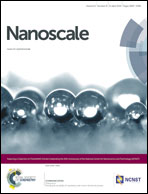Cu2−xSe@mSiO2–PEG core–shell nanoparticles: a low-toxic and efficient difunctional nanoplatform for chemo-photothermal therapy under near infrared light radiation with a safe power density†
Abstract
A low-toxic difunctional nanoplatform integrating both photothermal therapy and chemotherapy for killing cancer cells using Cu2−xSe@mSiO2–PEG core–shell nanoparticles is reported. Silica coating and further PEG modification improve the hydrophilicity and biocompatibility of copper selenide nanoparticles. As-prepared Cu2−xSe@mSiO2–PEG nanoparticles not only display strong near infrared (NIR) region absorption and good photothermal effect, but also exhibit excellent biocompatibility. The mesoporous silica shell is provided as the carrier for loading the anticancer drug, doxorubicin (DOX). Moreover, the release of DOX from Cu2−xSe@mSiO2–PEG core–shell nanoparticles can be triggered by pH and NIR light, resulting in a synergistic effect for killing cancer cells. Importantly, the combination of photothermal therapy and chemotherapy driven by NIR radiation with safe power density significantly improves the therapeutic efficacy, and demonstrates better therapeutic effects for cancer treatment than individual therapy.


 Please wait while we load your content...
Please wait while we load your content...